I’m making steady progress on my novel rewrite. Since getting back to work on it back on the solstice, I’ve put in a nice block of time nearly every day. (Besides Christmas Day, which I took as a holiday, I think I’ve missed two other days.)
The first third had already been rewritten back in the summer. I spent the first couple of days reading through that part and making minor edits. Happily, the edits were in fact minor. I fixed typos and minor sentence-level errors like poor word choice. I fixed the sort of scene-level errors that can only be spotted on a close re-read, such as saying something that I’d just said in the previous scene.
Once I got through that first third, progress slowed down quite a bit. The middle third of the novel had some serious structural problems. It had too many locations where too little happened. I’d already figured out that I needed to collapse that into two locations, and I’d taken a first pass at identifying which things happen in location A and which in location B, but now I had to make all that work.
That turned into kind of an odd mix. Sometimes I could just fix the name of the location and otherwise leave the scene alone. Other times the scene needed to be completely rewritten, because the action was only appropriate for a location that the characters no longer visited. (The latter was more work, but the former was worrisome in its own way—if the exact same thing could happen in the exact same way, perhaps my characters and locations were overly generic.)
Just yesterday and today I’ve been working on a bit that had (in an earlier draft) been written to be chapter one, to be followed with the story running along in two alternating threads, one present and one a flashback. I was pretty pleased with the chapter as a first chapter, but here in the middle, it’s all wrong. In particular, it has several bits written to establish the characters and their relationships. Those bits need to go, which is hard because they’re pretty good bits. Worse, they really ought to be replaced with references to stuff that happened earlier in the book—except that some of the bits they reference never got written.
So, that’s my task for tomorrow—spot those references, then go back and make sure that there’s actual text that establishes that aspect of the character’s relationship. Then decide which of the references should be edited to refer explicitly to those events and which should just be plucked out.
Writing this pass is weirdly different than writing a first draft. I spent a lot of mental effort trying (and often failing) to resist the urge to go back and edit as I went along. Now that I’m in the edit phase, my problem is just the reverse: each time I come upon something hard like this, my urge is to say, “Oh, I’ll leave that for the next pass.” Except that there is no next pass, at least not until my first readers come back with comments.
Still, steady progress is good. I’m about half-way through the middle third.
The final third, where the text draws heavily from the previously existing short story, will no doubt be yet another different experience. I’ve already gone through that part fixing stuff in the sequence of events and adjusting for how the characters had evolved in the writing of the novel-length work. At this point I really have no idea if I got most of that right, and that (having already been rewritten once) it will be like the first third, or if it will be like this middle third, needing major work. I know there’s be some significant new writing that needs to be done—I have a list of scenes that I’ve realized are missing—but beyond that I really have no clue how much work is sitting there needing to be done.
I’m can say that I’m happy with the draft up through this point. If I’m as happy with the second half, I’ll have no hesitation about sharing it with my first readers.


